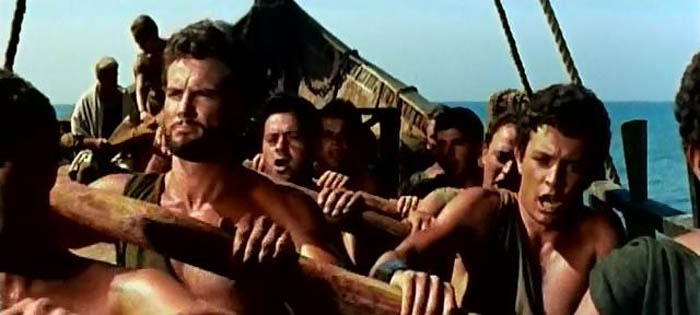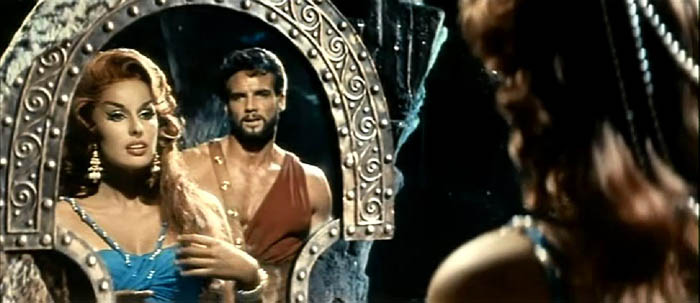Hercules (1958) and Hercules Unchained (1959)
Inspired by big-budget Hollywood movies about the ancient world, Italian film makers started producing their own movies based on ancient history and mythology in the late 1950s. French critics considered these films disposable entertainment and dubbed them peplum movies, named after the short tunics used by the actors. (An alternative designation for the genre is “sword-and-sandal”, which is nowadays used to denote any film set in ancient times.)
More than one hundred films were produced until the genre was superseded by the so-called “spaghetti western” in the mid- to late-1960s. Some well-known directors of these Italian-made westerns originally cut their teeth on peplum movies, most notably Sergio Leone, famous for The Good, the Bad and the Ugly (1966), who also directed large parts of The Last Days of Pompeii (1959). Unlike the peplum, the spaghetti western has become an established and well-respected genre.
But despite the negative critical reaction, peplum films proved to be extremely popular, and some of them were dubbed in English and exported to the United States. The earliest of these was Hercules (1958), starring American bodybuilder Steve Reeves. This movie established a template that many movies were to follow: the lead was usually played by a bodybuilder, a real man’s man, with the female love interest portrayed by an attractive actress, who excelled at being a damsel in distress, set against a backdrop of ancient intrigue, history, and mythology, with exciting action sequences that allowed the actor to flex his not inconsiderable muscles. Other bodybuilders were to follow in Reeves’s footsteps, including Reg Park (e.g. Hercules and the Captive Women; released States-side in 1963), Arnold Schwarzenegger (Hercules in New York; 1969), and Lou Ferrigno (e.g. Hercules; 1983).

The 1958-Hercules, directed by Pietro Francisci, plays fast-and-loose with Greek mythology. The movie features Hercules’ struggle with the Nemean Lion and the Cretan Bull, but skips any other labours. Instead, the plot follows a very light treatment of the story of the Argonauts and the Golden Fleece.
In the original story, immortalized in the Argonautika by Apollionus of Rhodes, Jason was the main character and Hercules joined the crew only for a short while before abandoning the expedition. In the movie, their roles are reversed: Hercules is the main character, with Jason (Fabrizio Mioni) relegated to the supporting cast. He only gets a brief moment in the limelight when he fights the dinosaur-like dragon that guards the Golden Fleece in Colchis.
Many elements of the story of the Argonauts are omitted or changed. Medea and her father Aeëtes do not appear in the movie at all, and the quest for the Golden Fleece is turned into a slight murder mystery. The emphasis is put squarely on Hercules, who came to Iolcus (“Jolco”) at the request of King Pelias (Ivo Garrani) to tutor his son Iphitus (Mimmo Palmara). Once in Iolcus, Hercules inevitably falls in love with the king’s beautiful daughter, Iole (Sylva Koscina).
The movie opens with a text crawl that reads:
Immense and immortal was the strength of Hercules, like the world and the gods to whom he belonged… Yet from lesser men he learned one eternal truth – that even the greatest strength carries with it a measure of mortal weakness…
These opening lines underscore the tragic nature of the hero that, for the most part, is skirted in the movie itself. (By the way, the text is different in some versions of the movie.) When Pelias’ son Iphitus gets killed, Hercules feels responsible and tries to set things right. But the more unsavoury aspects of the Hercules myth are ignored. He never enters into an uncontrollable rage, nor does he murder his family. The love interest – Iole – is an interesting choice: in Greek mythology, Iole indirectly caused Hercules’ death when his second wife, Deianira, became jealous of her. By not including either Megara – Hercules’ first wife – or Deianira in the movie, Iole (recast as the daughter of Pelias) becomes an innocent object of desire. Hercules and Iole marry at the end of the movie, providing a happy end uncharacteristic of Greek mythology in general.

Another interesting change in Hercules from established myth is the inclusion of a young Odysseus (Gabriele Antonini), who like Hercules himself is referred to throughout by his Roman name, Ulysses. The movie even suggests that it was Hercules who instructed Ulysses in the arts of archery – those familiar with the importance of the bow in Homer’s Odyssey will appreciate this detail.
Hercules Unchained (1959), also directed by Pietro Francisci, is a direct continuation of Hercules. Hercules, Iole, and Ulysses head to Thebes to find the city in disarray. Where the first movie borrowed liberally from the story of the Argonauts, this movie plays around with the story of the Seven against Thebes. Hercules gets caught up in the fraternal struggle over the kingdom of Thebes between the madman Eteocles (Sergio Fantoni) – who refuses to relinquish the throne – and Polynices (Mimmo Palmara, who portrayed Iphitus in the previous movie).
Oedipus is shown briefly, but there is no mention of his marriage to his own mother (kudos to the film makers for his Sophocles-inspired exit, however). Similarly, the story of the Seven against Thebes is also altered. In the original tale, the battle was bloody and ended with the deaths of most of the main characters and countless individual warriors. For the movie, the battle for Thebes begins with a duel between Eteocles and Polynices, which ends with the two brothers killing each other. The army camped outside then nevertheless begins to besiege Thebes, which offers an opportunity for Hercules to topple a few siege towers.

A large part of the movie is taken up by Hercules and Ulysses getting imprisoned by Omphale (Sylvia Lopez), queen of Lydia. Hercules at one point drinks water that makes him forget who he is and he comes to believe that he is Omphale’s husband. Ulysses, making use of his legendary wit, manages to avoid suspicion by pretending to be a deaf mute, while at the same time trying to prevent Hercules from drinking the water in an attempt to have him regain his memory.
Again, the film makers make some changes to the original myth, which is best known from a late source (Diodorus Siculus). In the ancient story, Hercules was forced to serve Omphale for a year, during which time gender roles were reversed, with the hero performing female duties while also dressed as a woman. In the movie, however, Omphale is more similar to Circe or Calypso from the Odyssey, a seductive woman who manages to waylay Hercules for a while. Furthermore, Lydia is turned into an island for the purposes of the movie, whereas in actual history it was, of course, a part of Asia Minor.
When compared side-by-side, Hercules is the stronger movie. Hercules Unchained has a few good sequences, such as the hero’s struggle with the giant Antaeus (Primo Carnera), but overall is a bit of a disjointed mess. Hercules’ sojourn with Omphale quickly outstays its welcome, and there are a few nasty elements, such as Eteocles’ madness and an attempted rape of poor Iole, that make this movie simply not as much fun as its predecessor.
Both movies feature sets and costumes that, in form or another, have managed to endure, for better or for worse, to this day. Men are equipped with leather armour, including those unhistorical leather braces that cover most of the forearms. Helmets with stilted crests and shields modelled after ancient Boeotian-type shields (with scallops cut from the sides) appear in this movie and seem to have served as models for more modern films, such as 2004’s Troy.
Again, much of the costumes and sets are inspired more clearly by ancient Rome than ancient Greece: the troops gathered in front of the gates of Thebes are more akin to Roman legionaries and officers than Greek fighters of either the Bronze, Archaic, or Classical ages. Hercules Unchained even features a kind of arena, where the hero is forced to do battle with tigers.

The two Hercules movies starring Steve Reeves made a lasting impression that is felt to this day. Many of the conventions of the peplum genre in general also continue to exert their influence on recent releases. Both The Legend of Hercules and Hercules 3D, released this year, feature a scene where the hero is chained up briefly before using his superior strength to rip the chains from the walls: these scenes are clearly inspired by the sequence in Hercules (1958) where Reeves first escapes his bonds and then wraps the chains around two columns to tear down part of Pelias’ palace.
Both Hercules and Hercules Unchained are clearly the products of their time, but still eminently watchable. If you can find copies of these movies, I would recommend you give them a look, as they are the ancestors of modern sword-and-sandal epics and thus intriguing to those interested in both the ancient world as well as the history of cinema.
Further reading
There are a few good books on the depiction of the ancient world in movies, as well as a good overview of Hercules in particular in Stafford’s book (review forthcoming, obviously!). Here’s a list of the books that I think are useful if you wish to delve deeper into this topic:
- Alastair J.L. Blanshard and Kim Shahabudin, Classics on Screen: Ancient Greece and Rome on Film (London 2011).
- Jon Solom, The Ancient World in the Cinema (revised edition; New Haven and London 2001).
- Emma Stafford, Herakles (Abbingdon 2012).
There’s also a website devoted entirely to the sword-and-sandal genre of films, naturally called Peplum, which is worth a visit if you are interested in learning more about the genre.

1 comment
It’s almost impossible to find a release of Hercules with the full runtime of 1hr and 47 min. Also, with the original US release soundtrack dubbed in English. Most dvds have been cut by almost 20 minutes. I’d love to find a dvd that is the original U.S. release. Sad for us baby boomers that grew up with Steve Reeves as Hercules.